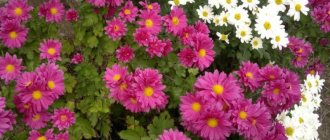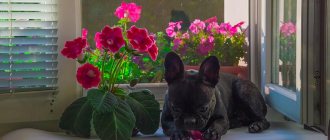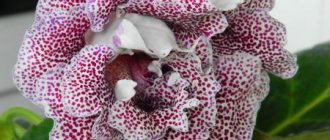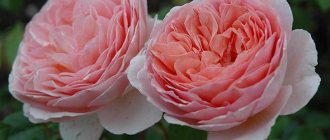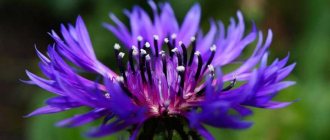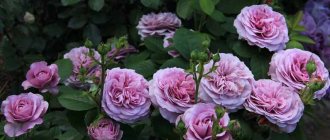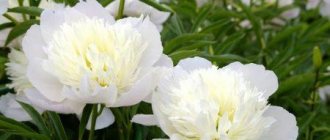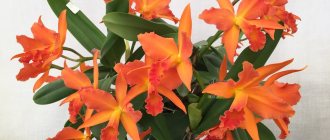Some plants got their names from the names of the people who studied and described them. What about the plants, even America was named after the famous navigator (although Columbus discovered it). This is how gloxinia received one name - gloxinia (Latin Gloxinia), after the name of the scientist who studied botany in Alsace - Benjamin Peter Gloxinn, and another - Sinningia (Latin Sinningia) - on behalf of Wilhelm Sinning, the man who laid the foundation for selection and hybridization this flower.
It is to him that we are grateful for the appearance of Gloxinia domestica and its many varieties (however, the second name never became widely used and did not take root). Gloxinia is native to America (its southern and central parts), where 25 species of this perennial herb or even subshrub are found. Its habitat is tropical deciduous forests or floodplains.
Classification of Gloxinia varieties
Depending on the size of the aboveground part of the plant and the rosette formed, hybrid gloxinias are divided into miniatures, which do not grow more than 20 cm, and standard plants, the diameter of the leaf rosette of which can exceed 30 cm. There are also a number of varieties that occupy an intermediate position in this classification.
On this topic:
BACK
FORWARD
1 of 5
The corollas of modern plants may consist of one or several rows of petals. Terry gloxinias are incredibly popular, because their bell-shaped flowers are more magnificent than simple ones, and their shape most closely resembles a camellia or a garden rose.
Based on the type of color, modern varieties of gloxinia are divided into plain, calico and tiger.
- Solid flowers are evenly colored in different tones from white, light pink or purple to purple and deep violet. Only the spot deep in the neck may be lighter or white.
- Corollas with a calico type of color are covered with uniform spots or speckles.
- Tigers are decorated not only with elegant polka dots, but also with a border around the edge of the petals.
Having seen the inscription gloxinia “Tigrina Red”, Blue or White on the package with the tuber, you can be sure that the manufacturer offers to grow a flower with an original corolla of a rich red or purple hue. However, it will not be possible to obtain the same plant from seeds, because hybrids reproduce only vegetatively.
In some varieties of gloxinia, the flowers have the shape not of the usual bell, but of a thydea, that is, a shoe, more often found in other plants belonging to the Gesneriaceae.
Gloxinias love bright, but not direct rays of the sun, are afraid of drafts and sudden temperature changes, and respond very negatively to excessive watering. It may seem that gloxinia is very capricious. But those who master plant care will not regret it. With due attention, the green pet blooms regularly from spring to autumn.
By autumn, the number of buds decreases, and then the aboveground part of the gloxinia fades. The plant begins a dormant period, during which life is preserved only in the tuber.
At home, a gloxinia plant can be obtained from a tuber planted in the spring or from seeds. You can propagate your favorite variety by rooting a healthy leaf. Thanks to this, many cultivated varieties are now more accessible than before.
Both foreign and Russian enthusiasts are engaged in the selection of gloxinia. The industrial varieties offered to amateur flower growers by large flower growing companies in Holland and other countries are widely known. Their assortment includes simple and double gloxinias, conventionally grouped according to the shape of the flowers, the size of the corollas and rosettes.
Types of Gloxinia
The subshrub or perennial herb is a representative of the Gesneriaceae family; it thrives in the deciduous forests of Peru, in the rocky areas of Mexico, in the Andes, and grows in pots on the windowsill.
The tropical guest turned out to be hardy and undemanding to care. In some species of gloxinia the stem rises to a height of 70 cm, in others it does not exist at all, and the shoots spread along the ground.
A rosette of velvety leaves of a dark green color stands out above the ground surface. They are oval in shape and pointed at the ends.
Gloxinia blooms for about 3 months, in March it produces bells, the diameter of each of them is from 8 to 12 cm. At least 8 buds are formed on one plant, sometimes their number amounts to 3 dozen.
White, crimson, purple or red petals on the corolla are arranged in rows. Flowers covered with villi are monochromatic; there are bells with stripes, borders, specks, double and smooth.
There are more than 20 plant species in the wild; various hybrid varieties have been bred from just two. Gloxinia Beautiful has a tall stem with original leaves, with a pattern of veins appearing on them. Bells come in a variety of colors - from white to purple and violet.
On the shoots of a small bush of Royal Gloxinia there are leaves covered with silvery fibers. Buds form on long peduncles; when they bloom, they reach 7 cm.
"Madame Margaret"
Attracts the eye with huge bright flowers with crimson-red petals framed by a white wavy border. There are specimens without bordering. After hibernation, the plant forms a compact bush with small peduncles and resembles an elegant bouquet.
monopotassium phosphate and warn against nitrogen-containing additives.
Did you know? Scientists distinguish 25 species of gloxinia. Only two of them are the founders of many hybrid varieties. By size they are classified into: standard (diameter from 25 cm), compact (12 - 25 cm), miniature (5 - 12 cm), microminiature (up to 5 mm).
Features of reproduction
Vegetative propagation is suitable for gloxinia; among other things, it is the simplest.
Using a leaf cutting (in two ways):
- Place the cutting in water and leave it there until the first roots appear. After this, plant in the ground for 5-7 days and cover with a jar.
- The shoot can be immediately placed in moist soil. After this, cover it with a jar or film for 2-3 weeks, keeping the temperature at 23 degrees.
Using a leaf plate:
- Take a healthy leaf.
- After this, make cuts on the convex veins into 2 or 3 parts and place it on the soil, pressing it a little.
- Expect small shoots to appear.
Fruit and berry ideas
Fruits and berries enrich our body with vitamins, cleanse blood vessels and make the morning even fresher, and therefore should certainly be present in every healthy breakfast. In addition, most of them are too high in calories to leave them for dinner, but in the early morning we simply need calories.
The best fruits and berries for breakfast: grapefruits and oranges, figs and dates, apples, blueberries and blueberries, mangoes, kiwis.
Yogurt mix
An incredibly tasty mixture for a light and healthy breakfast!
Mix yogurt with maple syrup, add a piece of pear, avocado, a handful of blueberries, and flaked almonds or coconut.
The downside to this dish is that it ends very quickly!
Figs with shrimps
An energy-filled dish for incorrigible workaholics!
Break or cut several figs without removing the skin. Boil a few shelled shrimp in salted water, then peel them and add to the figs. Drizzle with balsamic vinegar.
Small pieces of prosciutto or a slice of fried bacon complement this dish perfectly.
This seemingly unusual breakfast is perfect for those who prefer to eat a hearty meal in the morning to recharge their batteries before a long working day. After all, it contains almost the entire daily dose of amino acids, protein, vitamins and minerals, and on such “batteries” you can work productively until late in the evening.
Smoothie Tenderness
The most delicate light and healthy breakfast!
Alternately blend banana, kiwi and strawberries in a blender. As you cook, place the fruit mixture in multi-colored layers into a bowl or wide glass. Sprinkle the top layer of granola and leave for a minute, and then enjoy a fresh and flavorful breakfast!
Vitamin pudding
Breakfast like a cloud!
To prepare it, take 3-4 types of your favorite fruits, beat them in a blender, add chopped nuts (pine nuts are best) and 1-2 eggs, beaten with a little sugar and a pinch of salt. Stir the mixture and bake in the oven at 180°C for 5-8 minutes.
We hope that with our help you will add new unusual dishes to your morning menu tomorrow. Prepare breakfast with soul and love, discover recipes from all over the world! Every day is new, let's celebrate it beautifully!
In general, the main rule for a good start to the day is to eat what you like, prepare breakfast with soul and love, and believe that the best is yet to come!
Varieties
Gloxinia Kaiser exists in two types - Wilhelm and Friedrich.
Gloxinia Kaiser Wilhelm and Kaiser Friedrich are very compact indoor plants, with beautiful, rich, deep shades of flowers. The first has a dark purple color, or as it is also called “night” color, while the second is painted in a delicate crimson color. The first and second plants have a white border along the edges of the flowers, and the leaf blades are dark green with an emerald tint.
Important! The flower of these varieties has one feature - they can hibernate, that is, remain dormant for a certain time! If you are interested in the varieties and types of gloxinia, it will be useful to read the following articles telling about their diversity:
- Decorative gloxinia Sonata.
- The most beautiful Gloxinia Shagane.
- Hybrid gloxinia.
- Description of the Krasnoyarje and Red Riding Hood varieties.
- Climbing gloxinia vines.
- Charming Gloxinia Brokada.
- Gloxinia Rosalinda.
- White terry gloxinia.
- Gloxinia Pink.
Dolce Vita
Hotel
The Dolce Vita hotel is located in the center of Kirov, in its historical, cultural and business center, which perfectly combines business activity, entertainment and a calm, measured life.
Rooms at the Dolce Vita Hotel
The hotel has a rich number of rooms and is ready to satisfy the wishes of any client; at the Dolce Vita Hotel you can book both standard rooms and superior rooms.
This single room has a microwave and cable TV. Guests are provided with a bathrobe.
Single room with shower
Price from 1300 rub.
This single room has a microwave, soundproofing and satellite TV.
Price from 1700 rub.
Soundproofed single room with electric kettle. Guests are provided with a bathrobe.
Deluxe Single Room
Price from 2000 rub.
This twin room has a microwave and private entrance. Bathrobes are provided.
Large Twin Room
Price from 1440 rub.
This twin room has a electric kettle, private entrance and view.
Deluxe Twin Room
Price from 1440 rub.
This suite features a spa bath, microwave and cable TV.
Price from 2200 rub.
Description of the species
In South America, this plant is found everywhere: on the rocks of Mexico, in the forests of Peru, on the slopes of the Andes. An alien from the tropics also feels comfortable on the windowsills of Eurasia. The plant is easy to care for and easy to propagate.
The variety of species differs in the color of the inflorescences, their shape (bells or shoes), the number and arrangement of petals, and the size of the leaves.
Note! Flowers with petals arranged in several rows are especially attractive. This makes double flowers look like roses
If we consider gloxinia species as a whole, we can identify common features that are characteristic of all plants.
Features of Gloxinia
| Sign | Description |
| Bush | Low - usually a little more than 10 cm (although in the wild it can reach 1.5 m). |
| Root | In real gloxinia it looks like a carrot. Even in domestic plants it can reach 0.4 m. In Sinningia it is a fleshy tuber. |
| Leaves | Thick, green, sitting on a powerful stalk. They can be shaggy and smooth, oval and oblong, with hairs or fluff resembling velvet. Some varieties have a small diameter - up to 1 cm, others reach 0.2 m. They grow in groups of 3-4 pieces. or oppositely located. Form a low ground rosette. |
| Flowers | The most common form is an elongated gramophone* on a peduncle from 1 to 15 cm long. There are 5 stamens inside, each with 4 anthers. A straight ring-shaped pistil rises between them (may be absent in hybrids). |
| Fetus | A small cone-shaped box (up to 1 cm). Inside contains a seed - brown ellipsoids 1 mm long. |
Sinningia tuber
Bushes come in different sizes. It depends on the diameter of the foliage rosettes:
- less than 20 cm – miniature;
- 20-30 cm – semi-miniature;
- over 30 cm – standard.
All varieties of gloxinia are light-loving plants, but they can get burned from direct sunlight.
Note! A common feature of culture is seasonality. Even at home, gloxinias sleep in winter
Therefore, you should not be alarmed by the fact that the ground part dies off by November. The tubers remain viable and, with proper care, will sprout in the spring.
general information
Gloxinia is an indoor flower. Otherwise it is called sinningia. This is a herbaceous perennial plant. It has rhizomes in the form of tubers and is a representative of the Gesneriaceae family.
The leaves are velvety, grow in breadth, and are moderately thick. The leaves give off a pleasant, delicate scent. Gloxinia has very beautiful flowers. Each flower looks like bells or shoes. They are located on peduncles of different lengths. Flowers come in a wide range of shades. Color may vary.
For example, it can be white, pink, lilac, red, etc. Among all the variety of plants, there are simple varieties, terry ones. Along the edges of the flowers there is a border, a neat frill. The surface inside is strewn with specks of a darker or lighter color. The flowering period usually occurs in March and April.
In order for people to express their feelings, the language of flowers was invented in eastern countries. The meaning of gloxinia is love that occurs at first sight. Therefore, the plant is used as a kind of love talisman that brings peace and harmony to relationships.
The plant has an unusual ability. It helps in relieving fatigue and tension in a person who has been engaged in monotonous physical or mental work for a long time.
Its varieties are incredible in their coloring. The catalog, which presents all the options, can be seen on the website of Svyatoslav Siletsky. He collected all the specimens, even the plants that breeders came up with in 2015.
Reviews
Megotel rating / 10
Based on user reviews, Megotel Hotel Dolce Vita has a rating: .
Based on user reviews, Megotel Hotel Dolce Vita has a rating: .
Facilities:
Purity:
Accommodation:
Service:
About Hotel Dolce Vita
Hotel Dolce Vita Kirov
– an excellent business hotel with the best world traditions. It should be the first representative of the Dolce Vita chain in Kirov and fully complies with its high standards. He has already earned the approval of his clients, who appreciated all its advantages and benefits. The signature features of the Dolce Vita service include a comfortable sleep system, which all 6 rooms are equipped with: “Garden sleep system”. Comfortable, pleasant to look at, well-designed, with a full range of services, the hotel will not leave even the most severe critic indifferent.
Botanical description and history
The Gloxinia Kaiser bush reaches a height of up to 25 cm, so it will not take up much space. It also has repeat flowering, with new buds appearing instead of old ones. This cycle continues from spring until autumn. The open flower reaches from 7 to 8 cm in diameter, while up to 20 buds can bloom simultaneously on one plant, and the inflorescence itself consists of five petals.
Leaf plates that have a slightly downy surface and wavy edges are attached to small cuttings. Each of the leaves is quite large and reaches up to 20 cm in length. The leaves themselves are surrounded by large and beautiful flowers, which are located on relatively small peduncles. In general, the flower creates an excellent decorative composition.
This plant was discovered and described in contrasting Latin America, when one young amateur botanist Benjamin Gloxin participated in a sea expedition at the end of the 18th century. After this, the propagation of this flower took place in greenhouses.
Landing
Thanks to its ability to qualitatively decorate landscape design, black elderberry is a rather popular plant in private garden plots.
Important! The varietal variety does not welcome transplantation. It is allowed to do this only in the 1st–2nd year of life if absolutely necessary
The optimal time for the procedure is summer. The plant is dug up along with a lump of soil so as not to damage the root system, and transplanted to a new place where a hole has previously been dug that can accommodate both the rhizome and the soil lump.
Moreover, planting a variety does not require much effort - you just need to follow the sequence of the procedure, namely:
- Choose the right place. This is not to say that Madonna is afraid of the shadow or loves the light too much. The variety can grow in any light, but if you want the elderberry to bloom profusely, it is better to plant it in an open area or at least in partial shade. And the lack of light can have a bad effect on the decorative characteristics of foliage. As for the type of soil, you should give preference to fertile loams. The acidity of the soil should be pH 6.5–7.5.
- Observe the time range. The optimal time for planting black elderberry is spring (wait until the temperature outside is warm for at least a week or two, about +10°C without the risk of frost returning) or autumn, 2-3 weeks before the onset of cold weather, so that the plant has time to take root .
- Dig a planting hole. The optimal depth is 0.5 m.
- Carry out drainage, namely, lay the bottom of the hole with crushed stone (about 10–20 cm).
- Fertilize the soil. To do this, place a layer of nutrient mixture prepared from turf soil, humus, peat and sand on top of the drainage in a ratio of 2:2:1:1. It is also worth adding phosphorus (100 g) and potassium (50 g) to each well.
- Plant elderberry. In this case, the seedling should be placed in the hole so that the root collar is above the ground. Then the hole is filled with earth, which is compacted a little. The final stage of planting is watering: about 10 liters of water are used for one seedling.
A rooted Madonna seedling will begin to grow quickly and will delight the gardener with its inflorescences already in the 3rd year after planting.
Common varieties
Knowing what gloxinia looks like, it’s easier to choose a houseplant to decorate your home interior. Here you can sometimes get confused - there is such a variety of subspecies and varieties of terry specimens.
Subspecies of Gloxinia
| Name | Peculiarities |
| Gloxinia perennis | It is translated as “year-round” because it has a short rest period. You can recognize the variety by its leaf blades - they are reddish below. The fleshy shoots are speckled. Axillary flowers are collected on one peduncle. The bush reaches a height of 0.5-0.7 m. |
| Royal | Gloxinia is truly worthy of queens due to its beauty. It stands out for its velvety texture of dark green oval leaves, arranged in 4-6 pairs on a thick stem up to 10 cm high. Slightly drooping large bells with a diameter of 7 cm are painted in a dark purple hue. They are crowned with a long peduncle (about 20 cm). |
| Beautiful Gloxinia | At first glance it resembles a royal one, but differs in: · a variety of color shades (purple, pink, blue, white, violet); · shape of flowers; · lighter color of the plate. The leaves are broadly oval, with dense short fluff, located on long stalks. If you look closely, you can see the original relief pattern of veins. |
| Tiny | It stands out for its small legs containing 1 flower. The corollas have a short, two-colored storz – purple on top, white below. It fully justifies its name - the bush barely reaches 2.5 cm. Small on the plant and velvety oval leaves up to 1 cm long. |
Gloxinia regal
Based on subspecies, breeders create new beautiful varieties. The most popular among them:
- Yesenia is a delicate “rose” of rich beetroot color;
- Winter cherry - its burgundy petals are speckled with white;
- Southern night - with small inflorescences of a black and burgundy hue;
- Tigrina mix - the variety got its name because of the unusual pattern on lilac, crimson, lilac or white petals;
- Tiger Empress - large wine-red bells have wavy edges;
- Blue gloxinia Avanti - petals, painted in all shades of blue, have a white border along the edge;
- Blue and white - distinguished by an original combination of colors: the white edging from the edge smoothly turns into a blue tint, which, in turn, turns into purple;
- Cleopatra is a wonderful representative of chintz coloring. The white bells seem to be powdered with purple and pinkish peas;
- Blanche de Meru is characterized by a large velvety rosette, from which crimson open gramophones with a white core peek out;
- Blonde Giselle is grace itself. Large bells, dotted with purple or pinkish specks, bloom on the pubescent stem; there is a purple tint in the necks;
Variety Lady Jane
- Madame Margaret - the crimson petals have wavy edges framed by a narrow white border;
- Kaiser Friedrich is characterized by a bright crimson color of the petals framed by a wavy white border; the creamy neck is strewn with small specks;
- Gloxinia white - can be recognized by its large snow-white petals with a greenish-purple throat;
- in Gloxinia Courage, large white gramophones are diluted with pink specks;
- Merlin - behind the rich dark purple specks it is difficult to discern the true white shade of the petals;
- Lady Jane - dense small peas are scattered among the white flowers;
- Prins Albert - in this variety, a smooth transition from blue-violet to deep black visually transforms the petals into a royal mantle;
- pink gloxinia Tale in the middle is painted crimson, the lighter throat is strewn with dark specks;
- Under the name Fusion gloxinia they mean hybrid varieties that stand out for their variety of shapes and colors.
The color of gloxinia is decisive. It is the bright shades that primarily attract lovers of unusual indoor plants. Based on this feature, it is possible to create a classification based on shade.
Gloxinia varieties by color
| Shades | Names of varieties |
| Gloxinia terry white | Madonna, Article De Luxe, Snow Queen, Fairy Wreath, High Light, Minx, Stefania, Frosty Haze |
| Red Gloxinia | Brocade, Estasi, Bohemia, Parisian, Catharinka, Scarlett, Roi de Rouge, Etoile de Feu, May Queen |
| Gloxinia violet | Shagan, Starry Night, Eliza, Shahinya, Madama Butterfly, Neptune, Light Violet Avant |
| Burgundy Gloxinia | Kaiser Wilhelm (with wide white border), Dream of Love, Hope, Parure |
| Black Gloxinia | |
| Pink | Orlans, Masquerade, Pinik Flamingo, Rokoko Pink, Peach Rose, Dolce Vita, Triumph Tender |
Sinningia Conspicua
Gloxinia varieties
Sinningia varieties differ according to their characteristic characteristics: plant height, bush splendor, rosette diameter, type of corollas.
The corollas can be simple, consisting of a single row of petals, or terry, multi-layered. There is also a difference in color: from pastel to the darkest tones, with spots and edging. The following are the main varieties and photos.
Group of varieties of gloxinia Avanti avanti
Avanti are more often found in seed form for individual cultivation. This group is characterized by a neat rosette; on its leaves, velvety flowers look unusually impressive.
Gloxinia Yesenia
The terry hybrid from Holland has received mass cultivation throughout the world.
A voluminous plant up to 30 cm forms a green rosette and medium-sized cuttings, above which lush multi-layered flowers sway. The corollas are slightly open, reminiscent of rose buds, and when the bright scarlet or burgundy flower opens fully, a pinkish or snow-white border appears along the edge.
Gloxinia Hollywood
This is a very showy plant species, reminiscent of rich, bright purple velvet paper.
Petals can be both dark and light. The inside of the flower is light lemon, with bright purple specks. The hybrid blooms wildly, the green mass of leaves is collected in a compact rosette.
Black Hollywood
Characterized by deep purple, almost charcoal flowers without a colored center inside.
Flowering characteristics are similar to regular Hollywood.
Gloxinia Kaiser Wilhelm
The dark purple, simple-shaped flowers are decorated with a speckled center and bright white curling edges.
All this gives the plant a solemn, regal appearance and effectively distinguishes the variety from other subspecies.
Gloxinia Kaiser Friedrich
A bright crimson bell with a contrasting snow-white edging and a tiny light splash in the neck of the flower reveals the royal personage of the Kaiser Friedrich variety.
The petals are formed by a ruffle, and the outer side is dazzling white.
Bright purple, sometimes almost black, corollas are gracefully wrapped in a voluminous flounce. The thick color runs along the entire length of the corolla, with a light contrasting spot interspersed in the lower part. The green rosette produces medium peduncles.
Gloxinia Blanche de Meru
Gloxinia Blanche de Meru has 5 lily-white petals. It looks elegant and elegant.
The green leaves resemble velvet. The variety is not very demanding; it can withstand some errors in care.
Gloxinia Violacea
A classic flower with a simple shape. Purple inflorescences with a white neck covered with lilac splashes and wavy edges of the petals.
The flower stalks are tall, so the plant needs support when in full bloom. Flowering is long-term, from June to August.
Gloxinia Shagane
This terry variety with voluminous bell-shaped flowers is very beautiful; it immediately won the hearts of many amateur gardeners.
A very interesting purple Tiger with a greenish throat and a bright purple border. Original inserts in the form of boiling white petals distinguish it from other varieties. There are purple blotches on the light part.
Gloxinia Snow Queen
Another unusual variety. The corolla looks like a royal goblet, pale lilac in color, the depth is dark purple.
Lush airy petals are collected into a weightless shuttlecock.
Terry splendor
Gloxinia Zaznoba looks very attractive. Its double flowers have a large diameter and are white in color. The petals are covered with peas of a violet-purple hue, there is a lilac border with a violet tint. The variety is characterized by compact bushes.
Gloxinia Moon Shadow is a double variety, endowed with huge flowers. The petals have a wide purple frame; white inclusions add unusualness and tenderness to the flower. Among connoisseurs and professionals, the variety is recognized as a masterpiece.
Gloxinia Winter Cherry is similar in appearance to the previous variety, but its petals are decorated with small peas that play in burgundy and purple colors. The bushes look very beautiful in pots on window sills; the decorative effect is emphasized by a compact, neat bush with short peduncles.
Gloxinia Cleopatra is a double variety. An inexperienced person will not immediately be able to distinguish it from the Winter Cherry variety, which is due to its external identity.
One of the most beautiful terry varieties is the Milky Way variety. It immediately amazes with its luxury, unusualness and grandeur. The diameter of the flowers is very large. On the white petals there are specks (violet, lilac), along the edges the colors are less bright, which adds sophistication. The leaves are endowed with a silvery vein, the base of the leaf itself is light green. The peduncles of this variety are of medium length, but this does not reduce its visual appeal.
Varieties with unusual or solemn names are especially popular. For example, Gloxinia Calico Wedding. It can be presented to spouses as a symbolic anniversary gift. On the white background of the petals there are specks of lilac color. There is a thin rim at the edges (the specks there are very thick, the color is lilac). Terry Sudarushka is distinguished by its romance and playfulness. Medium-sized polka dots are clearly visible on the white petals. Their color is red with a pink tint. Sudarushka has strong peduncles and compact bushes.
The Pani Valevskaya variety is distinguished by its extraordinary decorative properties. The main color of the flowers is white, they are double. The border stands out clearly against the white background, as it itself is crimson-red. Compact bushes have small but strong peduncles.
Gloxinia Crimson Study has a red frame around the edges. On the petals you can see not only dark red polka dots, but also streaks, which adds exoticism. The peduncles of this variety are long.
Gloxinia Charm captivates with the contrast of a delicate terry white base and a rich pink frame around the edges. Bright pink peas are randomly placed throughout the flower. The flower stalks are medium-length and particularly strong; the bushes are neat and compact.
Enjoy attention
Salome is a flower with a white central part of the petals and pink dots on it. The border is painted in light pink tones. The stems of Strawberry are quite tall.
The Sharon Stone species is considered one of the most beautiful indoor plants. All thanks to the fact that its flowers are large, thick and double. Their peculiarity is the pink border of the petals.
Georgia is characterized by the presence of large double and white buds. There is a small amount of soft pink coating on the petals.
The Dolce Vita variety has incredible charm and can bewitch, as it has very large pink flowers with pearl notes. The petals are wavy.
Gloxinia Crimson is colored crimson. The petals themselves are white, and the inclusions are crimson. Against this background, beautiful large leaves with a bright green palette look very advantageous.
Gloxinia Priceless Luxury looks very attractive. Its double flowers have a crimson, sometimes cherry color. The stems of the plant in question are quite short, making the bush neat and compact.
Gloxinia Brocade is a representative of a series of hybrids. Characterized by a high level of terry. The bushes are compact, the stems are low, as they do not reach more than 20 cm in height, the leaves are small. The color of the petals varies, but pink varieties are most common.
Violacea has purple flowers. It is a houseplant and reproduces using tubers. The bush grows small, since its maximum height reaches only 25 cm. The leaves are dark green in color and velvety.
Voloshka is characterized by lilac-lilac tones. The throat of the flower is white, the petals are double with a large amount of specks. The inflorescences are large.
Gloxinia Sea Princess is a medium-sized bush with large double white flowers. The edges of the petals have a narrow purple or blue border.
Gloxinia Madagascar has large flowers. They are terry, velvet. Their color includes bright shades of blue. This is a rather whimsical indoor plant that loves warmth and light, but reacts painfully to direct sunlight. In addition, she loves a lot of moisture.
Features of reproduction and cultivation
Gloxinia is replanted in the spring after the flower has had a good rest.
The tubers are carefully removed from the pot, washed and dried to remove moisture.
They are not completely covered with new soil, which allows the leaves to come out faster. There is no need for watering for three days after planting.
Propagation of the flower:
- seeds;
- cuttings;
- dividing the tuber.
The leaf of the plant is cut and, without petioles, buried 5 ml into the ground, covered with polyethylene and placed in a warm place. The emerging sprouts are moved to the pot.
Gloxinia seeds, which are sold in a flower shop, are laid out on the ground, which you must remember to spray. Glass is placed on top of the container. The first shoots will appear in about 15 days. The seedlings are picked and planted in pots. Read more about how to propagate gloxinia from seeds here.
It is easy to propagate gloxinia by dividing the tubers with the sprouts. The cut on each of them is sprinkled with ash, the roots are sent to separate containers.
Astrologers attribute gloxinia to the constellation Taurus. This zodiac sign has pure energy, which has a positive effect on a person’s condition. The bright flowers of the plant soothe and improve your mood.
Growing seasons
May-June marks the period of the first flowering of gloxinia . Sometimes this period lasts all summer, but when there is a clear break, cut off the spent peduncles and upper leaves. Only 2-4 lower leaves remain on the plant. It is useful to apply nitrogenous fertilizers, as stepsons will begin to appear in the sinuses. Pinch, leaving only the strongest ones.
After a while, gloxinia will bloom again - it’s time to feed it again with complex fertilizers for flowering plants. But when the flowering has clearly come to an end, we reduce watering, the flower withers, dries up and goes into hibernation. We will cut off all the tops, leaving a couple of centimeters above the surface, and place the pot in the cellar, under the bath, any cool place where it will not disturb us, but we will not forget to water it once a month.
There is another way of wintering . It is necessary to shake the tubers out of the soil, place them along with a half-and-half mixture of substrate and vermiculite in a plastic bag with a zipper and store in the bottom drawer of the refrigerator. So you don’t have to think about gloxinia at all until spring.
Tiny plants that emerged from seeds are not sent into hibernation, but are watered little by little throughout the winter.
Similar flowers
- Violet - the plant belongs to the violet family. Grows mainly in regions with temperate climates. Terry gloxinia is a beautiful indoor plant that attracts with its large flowers. There are about 70 species of this plant.
- Gloxinia Avante white - belongs to the terry section. The shape resembles a camellia or a garden rose.
- Gloxinia Yesenia is a double Dutch hybrid. Reaches 30 cm in height and is a cultivated plant in the world.
- Gloxinia Prince Albert is a simple gloxinia variety with showy flowers. It has additional grace in the form of wavy edges.
Gloxinia is undoubtedly a beautiful flower. Growing it is not as easy as we would like, but it is worth it. Not a single guest will pass by without paying a single compliment to such beauty!
Interesting options
Gloxinia Madonna is popular for its color. Madonna flowers have a certain lacy airiness; they are white, and their middle is yellow or even lemon. The petals have a fringe, which visually makes the volume of the flower even larger. The stem on which the inflorescences are located. quite tall, it bears large leaves, the color of which is presented in light green tones. Flower growers note that Madonna is quite easy to propagate and is well accepted.
Gloxinia terry white has rather large flowers, the neck of which is colored green and lemon. The leaves are green with an emerald tint, the stem is characterized by high strength, but it is not very tall. The bushes are characterized by a high level of compactness.
Rose peach is a double gloxinia, which is painted in delicate shades of pink. In the central part of the petal there is a rather wide but blurred stripe. Its color is dark pink, but there are types with a softer palette in the center. Small white dots can be seen in the throat of the flower. The stem on which the flowers are placed is low. Sometimes there are flowers that are painted white, and their central part is pink.
The Snow Queen is a representative of terry gloxinias. Its flowers are quite large. The middle of the flower is purple and the rest of the petal is white. Although flower growers have options with a lilac color, which can be obtained through certain plant care technologies. The edges of the petals of such a plant are framed by a lilac line. The bushes are compact.
Gloxinia Constellation of Love is a bright double flower, which is bordered by a burgundy edge. The throat is painted in light, practical white tones. The petals are not very large, the stems are strong. Unpretentious in care.
"Madonna"
Like any representative of the genus, a flower during the active growing season needs to be fed with complex mineral fertilizer. It is recommended to apply it once every ten days.
After flowering, Gloxinia “Madonna” leaves and stems die off. The plant goes into a long period of dormancy. Therefore, after the first flowering, in June, flower growers remove the upper part, leaving the four lower leaves. Tender stepsons will soon emerge from their bosoms. You need to leave the strongest ones and fertilize the flowerpot so that growth begins. In a month, when you see the first buds, fertilizing is required for vigorous flowering. When all the buds have faded and all the foliage has faded, cut off the tops at a level of 1 - 2 cm from the soil.
"Madonna" is easy to care for, grows quickly and reproduces easily
Some important subtleties
Since the homeland of gloxinia is warm South America, this plant requires a little more attention than any other house flower familiar to our climate. Although numerous hybrid indoor varieties are still less whimsical and capricious. You should also remember that this plant is seasonal, and do not be alarmed if, after flowering ends, your new plant suddenly drops its leaves and withers. You just need to preserve the dormant tuber until spring, and again wait for the appearance of bright buds and lush greenery.
If you decide to give the interior of your home or office a pleasing multi-colored decoration, then compact and very impressive indoor gloxinias will be a very good choice. In addition to aesthetic splendor, they are able to fill the room with an exquisite, pleasant aroma.
Where and how to plant
Hybrids obtained by selection from tropical subshrubs are quite finicky. They will not produce buds if there is little light, the soil is not suitable, or the humidity is not satisfactory. Caring for gloxinia at home requires special attention to these points.
Important! Direct rays of the sun have a negative effect on hybrid varieties of gloxinia, but with a lack of light, the leaves stretch. In winter and autumn, when the day is shorter than 12 hours, you additionally need to turn on the lamp. Place the plant on a spacious window - western or eastern
It does not tolerate drafts, so during ventilation the flower pot must be moved to another place
Place the plant on a spacious window - western or eastern. It does not tolerate drafts, so during ventilation the flower pot must be moved to another place.
The flower loves moisture, but the leaves suffer from water; it is better to pour it into a tray.
During the flowering of gloxinia, it is better to keep the temperature in the room at 20–22 degrees; when it is resting, 10 is enough.
If the plant is hot, the leaves rise, and when it is cold, they fall.
In order for gloxinia to be dotted with buds, the soil must be:
- light;
- breathable;
- loose.
Such indicators are provided by leaf soil, peat, sand and turf. Expanded clay or pebbles are placed at the bottom of the container, which guarantees good drainage. Before planting the tuber, the soil is calcined in the oven or doused with steam to destroy fungi and bacteria.
A plastic or clay pot with a tuber is placed in a larger container. The indoor flower is replanted at the end of winter, using fresh soil each time. Gloxinia feels good near an aquarium or fountain, where the humidity reaches 70%.
Egg Ideas
The ancient Romans had a custom of starting a meal ab ovo, that is, “with an egg.” Modern nutritionists only confirm the correctness of this ancient rule and advise us to start a new day with an egg breakfast. After all, they contain the set of fatty acids and vitamins we need, which strengthen the immune system and speed up metabolism. And besides, eggs perfectly saturate the body, thereby reducing the need to consume high-calorie foods during the day. As a true descendant, Señor Ventura continues and develops the culinary traditions of his ancestors. And it offers unusual and easy-to-prepare egg dishes that are ideal for breakfast.
Air meringues
Very impressive breakfast! Delicate texture, melting protein and unusual presentation will impress anyone. In this case, for 1 serving you will need only 1 egg.
Carefully separate the white from the yolk. Beat the egg whites with a mixer into a strong foam (such that the mixture does not spill out if the bowl is turned over), place in a mound on a greased baking sheet and make a depression in the center. Bake for 3-5 minutes in an oven preheated to 180°C.
When the meringue is covered with a brown crust, take it out and place the yolk in the well. Place the meringue in the oven for a couple more minutes.
A variety of vegetable sauces go perfectly with this dish. Choose according to your taste!
Cold fried haute couture
A gourmet breakfast for a special morning!
Marinate the egg yolk in champagne for 10 minutes.
Stir the ricotta with heavy cream (30%) until smooth (you will need one part cream for two parts ricotta).
Blanch the broccoli (or asparagus, or just the zucchini skin) for 5 minutes in salted water, then blend with a couple of ice cubes. Pour the resulting mixture onto a plate - this green sauce will be the base. Using a pastry ring, place the ricotta and cream mixture on it, make a well in the center and carefully pour the pickled yolk into it.
This is a five star breakfast! In addition to aesthetic pleasure and amazing taste, you receive an impressive dose of protein and vitamins that heal your body and improve your mood!
Eggs “in a bag” with avocado and bacon
So simple - and so unusual!
Boil a couple of eggs in lightly salted water (no more than 5 minutes). Peel and pit the avocado, then slice each half lengthwise into thirds. Wrap each piece tightly with a slice of bacon and fry in a pan until lightly browned (no longer than 2 minutes).
Frittata with spinach, kupaty and mushrooms
Metamorphoses of a hearty omelette!
Turn on the oven to 180°C, and while it is heating up, fry the kupaty cut into pieces in olive oil until golden brown. Then add chopped spinach and mushrooms to them and simmer, stirring, for another couple of minutes. In a separate bowl, lightly beat the eggs and combine them with the mixture in the frying pan. Place the frittata in the preheated oven for 10-12 minutes.
Sprinkle with grated Parmesan before serving.
Italy - on your plate!
Most common types
Gloxinia Royal is one of the most popular and frequently encountered representatives. Its peculiarity is its small height (up to 10 cm), but the plant has strong shoots. They contain about 12 leaves, and they usually stand in pairs. The leaves themselves are quite large and can reach 20 cm in length. They have an interesting shape, resembling an oval. They are also characterized by a specific green color. The flowers have a dark purple color, they are quite large, since their diameter is on average 7 cm. They are pleasing to the eye in the summer.
The beautiful Gloxinia resembles the Royal one in appearance. The leaves of the plant have a slightly different color, since their shade is somewhat lighter. In addition, its leaves do not have silver veins. The beautiful Gloxinia has large flowers. They are most often purple, but purple variants may also occur.
Yesenia is popular among flower growers due to the fact that its flowers are double, and this looks very attractive from the outside. Their color is usually burgundy or beetroot. The flowers on the bush are placed abundantly, and the bush itself is compact. The leaves on the outside resemble velvet.
ITALIAN MOTIF
Strictly speaking, Italians don't eat breakfast. At least in our understanding. An Italian breakfast is, at best, a cappuccino with a croissant or any sweet roll in the nearest coffee shop, and certainly standing up in five minutes. But Mediterranean cuisine is so tasty, simple and harmonious that many of them can be safely recommended as the healthiest and healthiest breakfast in the world. Personally, I never leave home without a good breakfast. Benedetto Ventura, brand chef of the Locanda dei Benedettini restaurant, developed the perfect morning menu especially for me and my Russian friends. And this gift is worth sharing! Now my breakfasts can be called the most exquisite, and it takes me no more than 15 minutes to prepare them.

